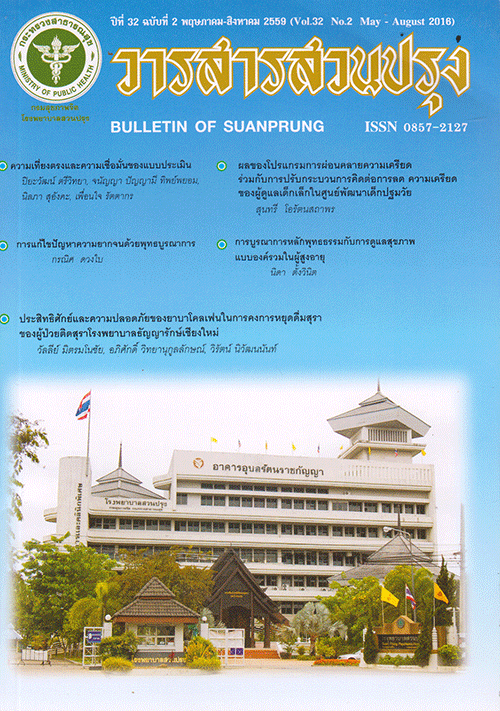ความเที่ยงตรงและความเชื่อมั่นของแบบประเมิน Psychosocial Impact of Assistive Device Scale (PIADS) ฉบับภาษาไทย
Main Article Content
Abstract
วัตถุประสงค์ เพื่อศึกษาความเที่ยงตรงและความเชื่อมั่นของแบบประเมิน Psychosocial Impact of Assistive Device Scale (PIADS) ฉบับภาษาไทย
วิธีการ แบบประเมิน PIADS ได้รับการแปลจากภาษาอังกฤษมาเป็นภาษาไทยตามแนวทางการปรับแบบประเมินให้เหมาะสมตามวัฒนธรรมประกอบด้วย ระยะที่หนึ่งขั้นตอนการแปลแบบประเมินต้นฉบับภาษาอังกฤษเป็นภาษาไทย (forward translation) และการแปลย้อนกลับ (back translation) แล้วเปรียบเทียบกับแบบประเมินภาษาอังกฤษโดยคณะผู้วิจัย ระยะที่สองเป็นการตรวจสอบคุณภาพของแบบประเมิน โดยการหาความเที่ยงตรงเชิงเนื้อหาโดยผู้ทรงคุณวุฒิ จำนวน 3 คน แล้วนำแบบประเมินที่ปรับปรุงไปทำการประเมินความเข้าใจในความหมายและความเหมาะสมของภาษาโดยกลุ่มตัวอย่างผู้พิการทางการเคลื่อนไหวจำนวน 5 คน จากนั้น ทำการศึกษาความเชื่อมั่นของแบบประเมินโดยการหาค่าสัมประสิทธิ์อัลฟาของครอนบัคและค่าสัมประสิทธิ์สหสัมพันธ์ภายในกลุ่ม (Intra-
class correlations coefficient: ICC) ในกลุ่มตัวอย่างที่เป็นผู้พิการทางการเคลื่อนไหว
ผลการศึกษา ความเที่ยงตรงเชิงเนื้อหาของแบบประเมินจากการพิจารณาของผู้เชี่ยวชาญ จำนวน 3 ท่าน พบว่า ส่วนใหญ่เห็นด้วยกับข้อคำถามที่แปลเป็นภาษาไทยโดยคณะผู้วิจัยแต่มีข้อคำถาม จำนวน 6 ข้อ ที่ต้องได้รับการปรับปรุง เมื่อนำแบบประเมินที่ปรับปรุงแล้วไปใช้ในกลุ่มตัวอย่างที่เป็นผู้พิการทางการเคลื่อนไหวจำนวน 5 คน พบว่ามีความเข้าใจโดยไม่มีข้อคำถามใดๆ ผลการศึกษา
ความเชื่อมั่นของแบบประเมินในกลุ่มตัวอย่างจำนวน 31 คนพบว่าค่าสัมประสิทธิ์อัลฟาของครอนบัค มีค่าอยู่ระหว่าง 0.82 – 0.96 และค่าสัมประสิทธิ์สหสัมพันธ์ภายในกลุ่ม (ICC) ขององค์ประกอบรายด้านและโดยรวมอยู่ในช่วง 0.68 – 0.84
สรุป แบบประเมิน PIADS ฉบับภาษาไทยมีระดับความเที่ยงตรงเชิงเนื้อหาและความเชื่อมั่นเพียงพอในการนำมาใช้ประเมินผลกระทบที่เกิดจากการใช้อุปกรณ์ช่วยผู้พิการในบริบทของสังคมไทยได้ อย่างไรก็ตามควรมีการศึกษาคุณสมบัติในการวัดเพิ่มเติมเมื่อนำไปใช้กับกลุ่มผู้ป่วยที่มีลักษณะอื่นๆ
Objective: To explore the validity and reliability of the Psychosocial Impact of Assistive Device Scale (PIADS): Thai version.
Method: The PIADS English version has been translated into Thai language by using a standard protocol for the questionnaire’s cross-cultural adaptation. The protocol consisted of two steps; firstly, forward translation from English into Thai and back translation from Thai into English were carried out by researchers. Secondly, the content validity of PIADS: Thai version was processed by an expert panel discussion, and pretested in 5 respondents. The internal consistency and intra-class correlation coefficient of the PIADS: Thai version were evaluated by using 31 respondents who have physical disability and use assistive devices.
Result: The expert panel discussion accepted the translation. However, six questions needed improvement. The result of the pretest showed that the five respondents clearly understood the content of the questionnaire. The results of the study of thirty-one respondents showed the Cronbach’s α coefficient ranged from 0.82 - 0.96 and the intra-class correlations coefficient: ICC (model 3, 1) ranged from 0.68 - 0.84 for both the overall scale and three subscales.
Conclusion: The study indicates that the PIADS: Thai version has content validity and reliability adequate for assessing the impact of assistive devices on the lives of people with disabilities in the Thai context. However, further study should be conducted before applying the PIADS to other groups of people with disability.
Article Details
บทความหลังผ่านการปรับแก้จากกองบรรณาธิการแล้ว เป็นลิขสิทธ์ของวารสารจิตเวชวิทยาสาร โรงพยาบาลสวนปรุง กรมสุขภาพจิต กระทรวงสาธารณสุข ห้ามเผยแพร่เพื่อประโยชน์ทางการค้าโดยไม่ได้รับอนุญาต แต่อนุญาตให้เผยแพร่บทความดังกล่าวเพื่อประโยชน์ทางการศึกษาแก่ประชาชนทั่วไป ทั้งนี้กองบรรณาธิการไม่จำเป็นต้องเห็นด้วยกับบทความหรือข้อคิดเห็นใดๆ ที่ปรากฏในวารสารสวนปรุง
References
Cushman LA, Scherer MJ. Measuring the relationship of assistive technology use. Assistive Technology. 1996;8:103-9.
Sirisamod T, et al. Revision the packages of benefit and accessibility to service of assistive devices for disabled people. Nontaburi: Ministry of Public Health; 2014. [cited 2015 May 22]. Avaliable from: http://www.hsri.or.th/researcher/research/new-release/detail/5963 (in Thai).
Scherer MJ. Outcomes of assistive technology use on quality of life. Disability & Rehabilitation. 1996;18:439-48.
Murphy J, Markova S, Moodle E. AAC system: Obstacles to effective use. European Journal of Disorder of Communication.1996;31:31-44.
Prasertchong R. Annual budget report 2003: Case study for support of assistive devices for disabled people. Nontaburi: Department of Medical Services, Ministry of Public Health; 2003. (in Thai).
Chaisin A. A survey of using and needing of the assistive devices in elderly people at Ban Hauykeing, Tombon Nonghan, Aumphor Sansai Chiangmai Province. Chiangmai: Chiangmai University; 2010. (in Thai).
Chittabumrung C. Assistive technology. [cited 2015 May 24]. Available from: http://gotoknow.org/blog/chotiros7/212467. (in Thai).
Baum C, Christainsen CH. Person-environment-occupational-perfromance: An occupation-based framework for practice. In: Christiansen CH, Baum C, editors. Occupational therapy: Performance, participation, and well-being. Thorofare, NJ: SLACK Incoorporation; 2005.
Riewpaiboon W. Revision for developmemt of knowledge in rehabilitation system for improvement quality of life among disabled people. Nontaburi: Sirindhorn National Medical Rehabilitation Center, Department of Medical Services, Ministry of Public Health; 1999. (in Thai).
Jutai J, Day H. Psychosocial Impact of Assistive Devices Scale (PIADS). Technol Disabil. 2002;14:107-11.
Maneewan S. The Survey of the use of assistive devices of stroke patients. Chiangmai: Chiang Mai University; 2008. (in Thai).
Scherer MJ, Sax C, Vanbiervliet A, Cushman LA, Scherer JV. Predictors of assistive technology use: The importance of personal and psychosocial factors. Disability & Rehabilitation. 2005;27:1321-31.
Day H, Jutai J. The Psychosocial Impact of Assistive Devices Scale: PIADS. Ottawa: University of Ottawa; 1996.
Scherer MJ, Glueckauf R. Assessing the benefits of assistive technologies for activities and participations. Rehabil Psychol. 2005;50(2):132-41.
Buning ME, Angelo JA, Schmeler MR. Occupational performance and the transition to powered mobility: A pilot study. Am J Occup Ther. 2001;55(3):339-45. Am J Occup Ther
Jutai J, Day H, Campbell KA. Development of a scale to measure the Psychosocial Impact of Assistive Devices: Lessons learned and road ahead. Disabil Rehabil. 2002;24:31-7.
Demers L, Monette M, Descent M, Jutai J, Wolfson C. The Psychosocial Impact of Assistive Devices Scale (PIADS): Translation and preliminary psychometric evaluation of a Canadian-French version. Qual Life Res. 2002;11: 583-92.
Hsieh YJ, Lenker J. The Psychosocial Impact of Assistive Devices Scale (PIADS): Translation and psychometric evaluation of a Chinese (Taiwanese) version. Disabil Rehabil Assist Technol. 2006;1(1-2):49-57.
Orellano EM, Jutai J. Cross-cultural adaptation of the Psychosocial Impact of Assistive Device Scale (PIADS) for Puerto Rican assistive technology users. Assist Technol. 2013;25:194-203.
Jutai J. World frequency count of PIADS [updated July, 2008. [cited 2015 May 25]. Available from: http://www.PIADS.ca/contacts_graph1.2.asp.
Guillemin F, Bombardier C, Beaton D. Cross-cultural adaptation of health-related quality of life measures: Literature review and proposed guidelines. Journal of Clinic Epidemiology. 1993;46:1417-32.
Portney LG, Watkins MP. Foundations of clinical research: Application to practice. 2nd ed. New Jersey: Prentia-Hall. Inc; 2000.
Day H, Jutai J. PIADS Manual: The Psychosocial Impact of Assistive Device Scale: Version 4.2b Faculty of Health Sciences, University of Ottawa; 2003.
Nunnally JC, Bernstein IR. Psychometric theory. 3rd ed. New York: Mcgraw-Hill; 1994.
Moons P, Budts W, De Geest S. Critique on the conceptualisation of quality of life: A review and evaluation of different conceptual approaches. Int J Nurs Stud. 2006;43:891-901.
Lenker JA, Scherer MJ. Psychometric and administrative properties of measures used in assistive technology device outcomes research. Assist Technol. 2005;17:7-22.
